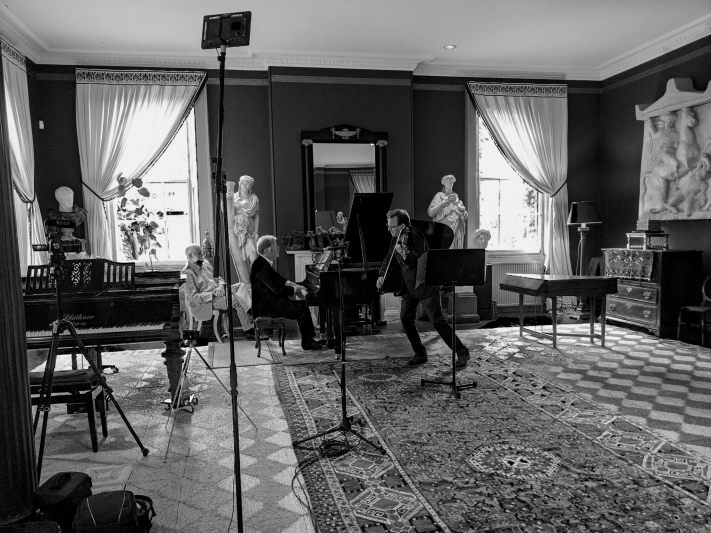Robert and Caroline Jackson, for charity and in association with Oxfordshire music groups, have for the last 15 years hosted three concerts a year at their New House home in Southmoor, South-West of Oxford. In the enforced absence just now of live music, on Sunday the Orchestra of St John's put out on its YouTube channel a Schubert/ Fauré recital filmed at New House.
Caroline Jackson is herself a pianist, and what a setting is the New House airy music room to play in. It houses a spinet and two pianos, one the Model B Steinway employed here by pianist Tim Horton. On the floor is a handsome Persian carpet, and at one wall is a cast of a tombstone from Athens, contemporary with the Parthenon, depicting Dexileos, a warrior meeting his death in the Peloponnesian War. Behind Mr Horton and our violinist Jan Schmolck loomed two 17th-century plaster cast statues from a Brussels atelier of two of the four moral virtues, Fortitude and Prudence – uncannily apt ideals and admonitions for these troubled times.
Schubert was just 19 when he composed his Violin Sonatina in D major, one of three designated in the 18th-century fashion as ‘sonatas for piano, with violin accompaniment’. He injects a bit of drama into the opening allegro molto, with Jan Schmolck's elaborately swaying body movement serving to counteract his notional subsidiary rôle. Our duet straightaway established their sharing of the same sense of propulsion for the whole length of the recital, whether through longish sequences of harmony or punchy statements or phrases that come to a halt at the edge of an emotional cliff. In this opener Schubert’s compact movement is amiable, with a jaunty second subject. The wrapping of the andante enclosed a plaintive melody for violin before we moved on in the allegro vivace to the alternating of a lilting, almost gypsy-music rhythm with some quasi-austere counterpoint.
Fauré's well-known Violin Sonata No. 1 in A major is a more sinewy piece altogether and contains an intriguing mix of restraint and verve. Tim Horton opened with a very long, supple span of bars and then when the violin joined him Schmolck never pushed the piano’s thematic material from the stage with his accompaniment figures. The balancing of the two instruments was a grateful feature, and so the players captured every scrap of detail in the score. In the scherzo, its tantalizing cross-rhythms were expressed, with delicate finger work from Horton's piano set against the violin's little rushes of pizzicato. A delightful feature in the finale is the way the coda allows the violin just about its only bit of pure virtuosity in the work, and Schmolck suppressed the scales as pianissimo until the very last bars.
In the interval we first heard a brief chat between Mr Schmolck and John Lubbock, the OSJ's founder and musical director, in which they agreed on the joys of having control over one's own orchestra. We were then whisked outdoors for a tour of New House's capacious gardens. They are divided into compartments, some bounded by arcaded hedges of hornbeam; a very striking feature. In the main the gardens are formal on a classical model and dotted with statuary - notably of Emperor Hadrian's lover from his holiday villa at Tivoli outside Rome, a Della Robbia Virgin & Child and a head of Zeus agreeing to intervene in the Siege of Troy.
As the camera followed Mr Jackson and his companion through the plantings and past the expansive pool, individual plants were hard to make out but I thought I spotted a mature Acer Drummondii, walls draped in Buttercup ivy, immaculately-clipped weeping silver pears, acanthus mollis (bear's breeches') and a sour cherry tree, with classical allusions everywhere one looked: a bust of Homer, a hint of abandon in a piece depicting Silenus, a drunken follower of the God Dionysus, and also a poetical pavilion, its windows etched with among other verses a garden allusion from The Winter's Tale.The concert is available to watch online here, and donations to OSJ's work can be made here.




